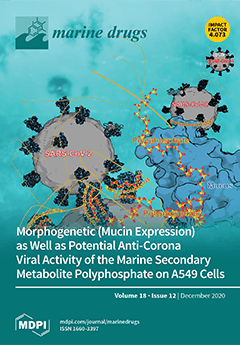Spirulina is a phytosynthetic filamentous cyanobacterium with microscopic dimensions, which naturally grows in the highly-salted alkaline lakes of Africa, Mexico, America, and Asia. Several bioactive peptides extracted from
Spirulina were demonstrated to possess antimicrobial, antiviral, antitumor, immunomodulatory, antiallergic and antihypertensive properties. It has
[...] Read more.
Spirulina is a phytosynthetic filamentous cyanobacterium with microscopic dimensions, which naturally grows in the highly-salted alkaline lakes of Africa, Mexico, America, and Asia. Several bioactive peptides extracted from
Spirulina were demonstrated to possess antimicrobial, antiviral, antitumor, immunomodulatory, antiallergic and antihypertensive properties. It has been reported that the consumption of
Spirulina could prevent or manage metabolic syndrome components. In women, metabolic disorders are more prevalent during menopause. Postmenopausal women present higher waist circumference, increased blood pressure, hypertriglyceridemia, hyperglycemia, and decreased HDL-cholesterol values, leading to an increased risk of cardiovascular events. Therefore, in order to prevent cardiovascular diseases, it is essential to manage the components of the metabolic syndrome during the postmenopausal period. As recent reports indicated the efficiency of
Spirulina supplementation in the management of the metabolic syndrome components, our study aims to review all the clinical trials conducted on this topic. Our main objective is to have a better understanding of whether and how this cyanobacterium could manage the abnormalities included in the metabolic syndrome and if it could be used as a therapeutic approach in postmenopausal women with this condition. We selected relevant articles from PubMed, Google Scholar and CrossRef databases, and a total number of 20 studies met our criteria. All included clinical trials indicated that
Spirulina has positive effects in managing metabolic syndrome components.
Spirulina is a valuable cyanobacterium that can be used as a food supplement for the management of metabolic syndrome, and it is able to reduce the risk of cardiovascular events. The optimal dose and period of administration remain a debated subject, and future investigations are required. Considering the beneficial effects reported against each component of the metabolic syndrome,
Spirulina could also be effective in the postmenopausal period, when this syndrome is the most prevalent, but there is a strong need for human clinical trials in order to sustain this observation.
Full article






